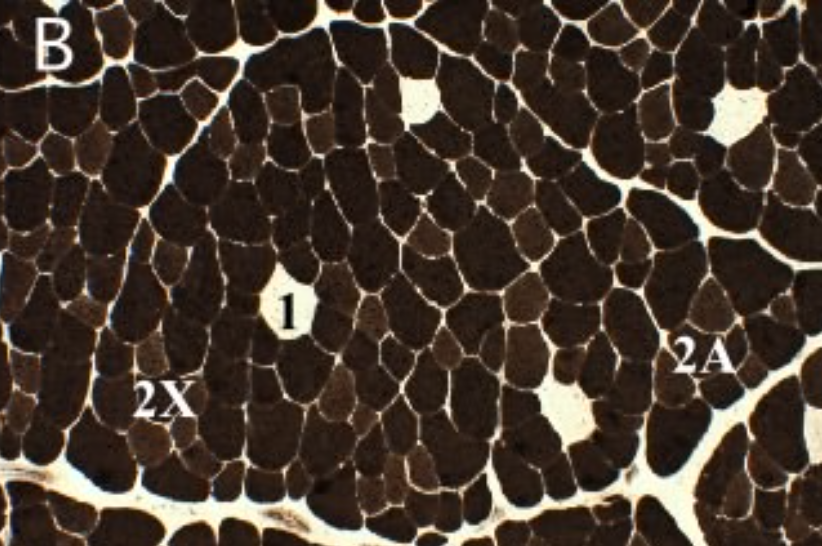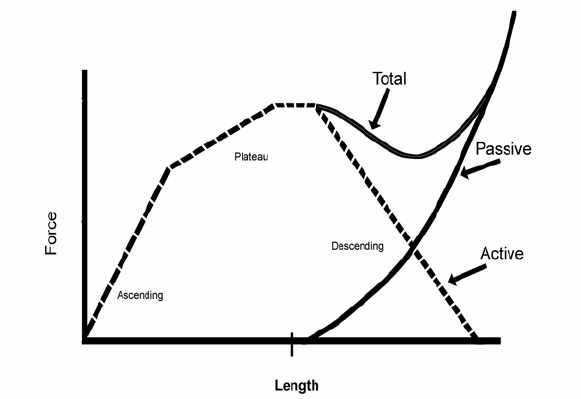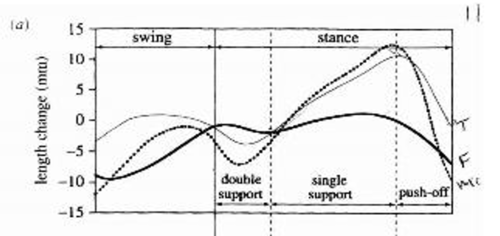Lecture 9: Muscle Behavior and Physiology
1/137
There's no tags or description
Looks like no tags are added yet.
Name | Mastery | Learn | Test | Matching | Spaced |
|---|
No study sessions yet.
138 Terms
What are the three primary types of histochemical methods for identifying muscle fiber types?
Myofibrillar ATPase
Succinate dehydrogenase
Alpha Glycerophosphate Dehydrogenase (alpha-GP)
What does myofibrillar ATPase identify?
Identifies fast and slow twitch fibers
What does succinate dehyrogenase identify?
Identifies oxidative potential
(more oxidative = will show up darker)
What does alpha glycerophosphate dehydrogenase identify?
Identifies glycolytic potential
________ enzymes mark the type of muscle cells within a thin slice of muscle cross section
Muscle enzymes mark the type of muscle cells within a thin slide of muscle cross section
What is occurring during the myosin ATPase reaction? What does this allow you to identify?
On the head of the myosin molecule, an enzyme hydrolyzes ATP to breakdown the ADP and Pi
Able to identify a muscle that has a lot of ATPase (fast twitch) and muscle that has very little ATPase (slow)

If succinate dehydrogenase was used, what does a dark color indicate?
Has a lot of mitochondria (high oxidative capacity of the muscle)
Slow twitch fibers are oxidative and therefore will react well with succinate dehydrogenase
What is Alpha GDP? What does is do?
Enzyme of anaerobic metabolism; helps breakdown glycogen in the cell (happens in the cytoplasm)
Considering the three histochemical methods (ATPase, SDH, and Alpha-GDP), how does fast-glycolytic respond to each of them?
↑ ATPase
↓ SDH
↑ Alpha-GDP
Considering the three histochemical methods (ATPase, SDH, and Alpha-GDP), how does fast-oxidative-glycolytic respond to each of them?
↑ ATPase
↑ SDH (oxidative)
↑ Alpha-GDP
(stains dark for all three)
Considering the three histochemical methods (ATPase, SDH, and Alpha-GDP), how does slow oxidative respond to each of them?
↓ ATPase
↑ SDH (oxidative)
↓ Alpha-GDP
What are the three primary fiber types?
Type I Fiber — Slow Oxidative (SO)
Type IIa (Intermediate Fiber) — Fast Oxidative Glycolytic (FOG)
Type IIx — Fast Glycolytic (FG)
How many transitional fiber types are there?
8 Transitional Fibers
Specific antibodies attach to different _______ proteins
Specific antibodies attach to different myosin proteins (MHC — Myosin Heavy Chains)
What are the three types of MHCs (Myosin Heavy Chains)? What muscle fiber types do they coincide with?
MHC I — Type I Muscle Fiber
MHC IIA — Type IIA Muscle Fiber
May have 2 or 3 MHC types within the IIA fiber based on histochemical methods
MHC IIX — Type IIX Fiber Type
Why do most people base fiber typing on MHCs?
Because MHCs does not relate to the speed of muscle contraction, but rather on the structure and proteins present
What are the effects of resistance training on fiber types?
Increased PCSA
Hypertrophy
Transition of fiber types
How long does it take for the PCSA to increase from resistance training?
Take 4-8 weeks to see changes
How quickly can we see changes of protein in the myosin head (MHC)?
We can see processes of protein synthesis happening as quickly as 4 hours after exercise
Hypertrophy is greatest in which fiber type?
Hypertrophy is greatest in Type II fibers (mostly Type IIx, but Type IIa just behind it)
T/F: Type I fibers do not undergo hypertrophy
False
Type I fibers can still get hypertrophy, it is just more likely to occur in Type II fibers
Discuss the transition of fiber types. What is the typical order (for resistance training)?
IIX (FG) → to IIAX → IIA (FOG)
How does the transition of fiber types work for detraining?
Goes in the other direction, from IIA → IIX
What fiber type is ‘most abundant’ in untrained individuals?
Type IIX
What is the effect of endurance training on fiber types?
No hypertrophy (with running or cardiovascular training)
Transition of fiber types
What is the order of the transition of fiber types for endurance training?
IIX → IIAX → IIA
Same transition order that occurs with resistance training
T/F: With endurance training, we can transition Type IIX fibers all the way to Type I fibers
False! Fiber type transition does not go to Type I
finish later…
What motor units innervate Type IIx?
Fast Fatiguing (FF)
What motor units innervate Type IIa?
Fatigue Resistant (FR)
What motor units innervate Type I?
Slow (S)
What are the two strategies that can be used to increase force of a muscle contraction?
Increasing the number of motor units
Increasing the rate that the motor units are stimulated/firing (rate coding)
Large, proximal muscles tend to use ________ to increase the force of a muscle contraction
Large, proximal muscles tend to use recruitment to increase force of a muscle contraction
(that is, they tend to increase the number of motor units firing)
Small and distal muscles tend to use ________ to increase the force of a muscle contraction?
Small and distal muscles tend to use rate coding to increase the force of a muscle contraction
(that is, they increase the rate that the motor units are stimulated)
How do we increase strength?
Overload
Need to get intensity of contraction up to the point where we are into higher range of MVC (maximum voluntary contraction)
Focusing getting fast fatiguing motor units recruited
T/F: Motor units can be task specific
True
For example — some motor units of the biceps brachii are just recruited when going into flexion; others are only recruited when going into supination
What types of structures can limit movement?
Muscle
Bony structures
Nerve tissue
Connective tissue within the muscle
Connective tissue around the muscle really limits ROM
Which tissue layer is the most restrictive?
Perimysium
T/F: You can assess what limits the motion individually
False!
What are the three connective tissue layers surrounding a muscle?
Epimysium — around the whole muscle
Perimysium — around each fascicle
Endomysium — around each one of the fibers
Stiffness is represented as the ______ of the length tension curve
Stiffness is represented as the slope of the length tension curve
What is flexibility? Where on the stress-strain curve does this occur?
Flexibility is the end point of the tissue (most elongated position)
This will occur at the yield point in a stress-strain curve
At some point, muscle will lengthen past the optimal length, causing what to rise?
Passive tension
Discuss the length-tension curve.

Considering the length-tension curve, passive tension started around what length?
0.3 inches
What structure is responsible for flexibility?
Perimysium: one of the main things, CT within the muscle (see it more in two joint muscles)
What structure is responsible for stiffness?
Titin
Titin goes from the __ line to the __ line on both sides of the _______
Titin goes from the M-line to the Z-line on both sides of the sarcomere
Titin is attached firmly to the __________ but it is loose in the ______
Titin is attached firmly to the thick filament but is loose in the I-band
What is titin like in the I-band?
Titan is loose in the I-band
It is elastic in the I-band
As you stretch it, tension rises
What part of the sarcomere has no myosin?
I-band
During a strong active contraction, what is necessary regarding cross-bridging?
The same number of cross-bridges are needed on each side of the sarcomere
If there are more cross-bridges on one side of sarcomere, what happens?
The side with more cross-bridges will pull the thick filament toward that side, thus not allowing there to be an effective transfer of force through the sarcomere
What is responsible for maintaining the thick filament in the center with the same number of cross-bridges on each side of the sarcomere?
Elastic component of titin
_____ is the elastic region of titin
PVEK is the elastic region of titin
What happens when you stretch PVEK (the elastic region of titin)?
Creates passive tension
What four amino acids are in the region of PVEK?
Proline
Glutamate
Valine
Lysine
Female muscles tend to be _______ than male muscles, therefore meaning they are ____ stiff
Female muscles tend to be smaller than male muscles, therefore meaning they are less stiff
Muscular hypertrophy = _______ stiffness
Muscular hypertrophy = increased stiffness
Titin has an affinity for _______ and that seems to make it _______.
Titin has an affinity for calcium and that seems to make it stiffer
Stiffness in muscle influences what?
Influences that ease at which someone can move
Discuss the role of calcium binding and titin in relation to active stretching.
During an active stretch, calcium comes in and causes binding of the titin molecule to the thin filament
This causes shortening of the titin molecule
Leading to increasing stiffness which adds to the tension at any particular length
What happens to the titin molecule during an eccentric action?
Binding of titin to the thin filament
Increase passive tension (which adds to active contraction of the muscle)
Yields higher force
T/F: Tendon tends to change length as quickly as the parallel elastic component.
False
Tendon does not change length as quickly as the PEC
What happens to the parallel elastic component when the contractile (active) component shortens?
PEC also shortens
(follows the active component)
What happens to the parallel elastic component when the contractile (active) component lengthens / is stretched?
The PEC will be stretched as well
(once again, PEC follows the active component)
What happens to the series elastic component when the contractile (active) component shortens?
The series elastic component will lengthen
T/F: The parallel elastic component includes titin
True
During an eccentric contraction what is happening at the joint and muscle fascicles?
Joint = lengthening
Muscle Fascicles = staying nearly the same length
If the joint is lengthening and the muscle fascicles are staying the same length, what is happening to the tendon?
The tendon has to lengthen
T/F: Tendon is part of the SEC
True
There is a _____ delay between muscle contraction (or EMG activity) and actual movement.
There is a 300ms delay between muscle contraction and actual movement
What is the reason for the delay between EMG activity and observable movement?
Uncrimping of connective tissue (which is the tendon)
Tendon has to lengthen to the point where it gets stiff enough to cause motion
What is the delay that occurs between EMG activity and observable movement called?
Electromechanical Delay (EMD)
What is the function of tendon?
Important for force production
Passive force = we elongate the tendon —> tendon stores energy (able to explode and be more powerful)
Transmits force to the bone so we can move (connects muscle and bone together)
What would be the best architecture for efficiency/work?
Muscle would be directly on the tendon so it could register movement at the bone
This doesn’t happen since there is a delay (EMD)
Are EMG and force output essentially the same thing?
No! They are not the same thig
They can be correlated (and in large muscles, they are not correlated well)
EMG does not equal movement or force
EMG is the greatest during __________ contractions.
EMG is the greatest during isometric contractions
Rank the three different contraction types (concentric/eccentric/isometric) in terms of greatest EMG activity to least amount of EMG activity.
Isometric (greatest)
Concentric
Eccentric (least)
What contraction type (concentric/eccentric/isometric) can produce the greatest amount of force? Why?
Eccentric contraction (because of its passive properties
What exactly does EMG activity tell us?
Tells us that there is electrical activity and there is some sort of muscle contraction occurring
T/F: You need more muscle fibers recruited in an eccentric contraction compared to a concentric or isometric contraction.
False! (you actually need less muscle fibers recruited in an ECC contraction)
Why do you need less muscle fibers recruited in an eccentric contraction?
Because of the tendon (and the stored elastic energy that is in the tendon)
If the EMG is rising, but the force is not increasing, what is this called?
Electromechanical Delay (EMD)
What accounts for the EMD?
Compliance in the tendon
What is PMT?
Pre-muscle Tension
When it takes time for the stimulation on the nerve to get to the muscle
What occurs once the PMT arrives at the muscle?
EMG will rise
T/F: Large muscles, such as the latissimus dorsi and quadriceps, can produce more force than what their EMG shows
True! (another reason why EMG and force output are not the same thing)
T/F: Bone is hyperechoic
True (bone appears white on ultrasound)
What is the compliance in tendons?
3-7%
What muscles are active during midstance?
Plantarflexors
As they are lengthening through that period, they are creating an eccentric muscle contraction
Soleus and Gastroc pull tibia posterior, which locks knee in extension — tendon as a whole getting longer because going into DF, but muscle stays roughly the same
This then stores energy for it to be released during push-off
T/F: Less DF occurs during running
False!
More DF is occurring as well as more ECC controlling tibial advancement

Discuss this graph.
Dotted Line = Muscle Tendon Complex
Dark Line = Muscle Fascicle (labelled “F”)
Light Line = Tendon (labelled T)
Overall, the muscle-tendon complex lengthens as you go through DF phase in stance
Fascicle length doesn’t change much — may increase some but nothing near MT complex
If muscle fibers are staying isometric, what is occurring at the tendon?
Tendon is lengthening
Considering the gait cycle, why is lengthening of the tendon helpful?
Allows the storage of energy where it is needed in the next phase (when we start to shorten in the PF component)
Considering the gait cycle, why is this storage of energy more important during running than walking (or ‘normal gait’)?
In normal gait — don’t need to push off of PFs
When running — we need a push off (need storage of energy to push us off)
When tendon lengthens, this stores ___________ to help produce more _______.
When tendon lengthens, this stores mechanical energy to help produce more force
(consider a kangaroo — more compliant tendons and are able to lengthen much further)
To jump high we need a high _____ and a high _____ of contraction.
To jump high we need a high force and a high velocity of contraction
Considering the components needed to jump high, is a muscle (alone) able to do this? Why or why not?
No! Think about the force-velocity relationship (concentric action produces more force and slower speeds)
This where tendons can help as they store energy to aid with this
How long before you leave the ground (when jumping) does our center of mass (COM) start to go up?
250 ms